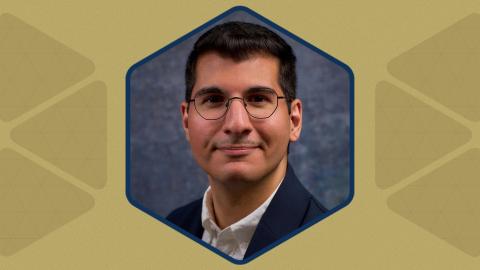Al Jamal’s research on origami-inspired phased array antennas represents a quantum leap in antenna reconfigurability at mm-wave frequencies and a paradigm shift in massive MIMO applications and beyond-5G communication.
Georgia Tech School of Electrical and Computer Engineering Ph.D. candidate Hani Al Jamal won first-place in the Student Paper Competition (Best Paper Award) at the 2024 IEEE International Microwave Symposium (IMS), held June 17-20 in Washington, DC.
This prestigious award recognizes top technical papers at the conference. His paper was selected out of the 306 total submissions eligible for this award this year.
His paper, “Beyond Planar: An Additively Manufactured, Origami-Inspired Shape-Changing, and RFIC-Based Phased Array for Near-Limitless Radiation Pattern Reconfigurability in 5G/mm-Wave Applications,” was co-authored by fellow ECE Ph.D. candidates Chenhao Hu and Nathan Wille, and ECE Professor Manos Tentzeris, in collaboration with George Mason University Electrical and Computer Engineering professor Kai Zeng.
Al Jamal and his team successfully demonstrated the first-ever additively manufactured, origami-inspired, shape-changing phased array at mm-wave frequencies, showcasing near-limitless reconfigurability. This work represents a significant leap, opening impactful opportunities for the advancement of massive MIMO and beyond-5G communication.
An origami-inspired, shape-changing phased array combines this traditional antenna function with the ability to electronically control the direction of the signal and mechanically change its shape through folding structures inspired by origami. This makes the antenna highly adaptable.
Al Jamal has been enrolled in the ECE Ph.D. program since 2022, and is a member of the ATHENA Lab, where he is advised by Tentzeris.
He received his bachelor’s degree in electrical and computer engineering from the American University of Beirut with high distinction.
His research interests include the use of additive manufacturing techniques in designing highly integrated, heterogeneous, and conformal/flexible RF systems encompassing RF front-end circuits, antennas, and packaging up to mm-wave frequencies. He is also keen on advocating engineering education to high school and undergraduate students.
Through his research, Al Jamal aspires to design and build communication devices and RF electronics that draw inspiration from origami and art, leading to enhanced functionality and physical flexibility to seamlessly integrate with human-centered devices, thereby enabling more efficient and integrated communication networks for digital awareness.
